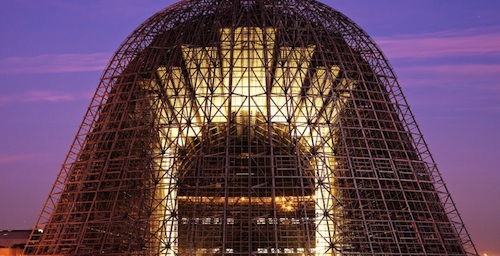In 1933, Hangar One in Moffett Field was built in northern California; at the time, it was one of the largest free-standing structures in the world. It was meant to hold the USS Macon, the largest airship in the world at the time — and one that crashed into the Pacific Ocean a little over two years later. Twenty to thirty years after that, Hangar One was mostly a NASA space (as well as some minor military operations). Now, it’s going to be home to Google — and their basic plan is to use the space for their robotics revolution. The airport and Hangar One structure was actually leased to Planetary Ventures, which is a Google shell company; in 2011, the top three executives at Google had made a $33 million refurbishment offer to NASA, although there were fears that they just wanted the space to park Google’s private jets.
This time, it’s not about private jets — it seems to be about robotics:
How about using its cavernous interior for building and testing new robots, planetary rovers and other space or aviation technology?
A NASA spokeswoman confirmed Tuesday that those plans are part of the proposal submitted by a subsidiary of the giant Internet company, along with restoring the outside of the landmark structure known as Hangar One at Moffett Federal Airfield. Based on that proposal, U.S. officials said this week they will negotiate a long-term lease with Google for a significant portion of the former naval base, including three historic hangars, two runways and some adjacent land and buildings.
While the company is best known for its Internet search engine, software and other online services, Google’s founders and several top executives also have a well-documented interest in robots, high-altitude balloons, aviation and space exploration.In recent months, Google has confirmed buying eight small robotics companies for a mysterious new division headed by its former Android software chief, Andy Rubin.
The most notable company they’ve bought is Boston Dynamics, notable because of this creation of theirs:
No one completely knows what Google will do in this Hangar One space, but consider these thoughts:
1. Hangar One is obviously an inanimate object, but damn, it’s seen some history. Blimps to NASA to Google? That’s basically three generations of major American innovation being housed and worked on in one place. I’m not sure there are a ton of buildings in America that could claim that.
2. Think about where Google started out at. It was a search engine with enough space for maybe two million queries a month, cutting deals with sales guys who probably totally forgot the company name six minutes after the meeting. Now they’re working with robots and space exploration and deep learning? Could you imagine if Yahoo or AltaVista (back in the day) was suddenly like, “You know what? Search is going OK. Let’s try to cure cancer?” People would be LOL’ing. Oh, and Google does all this while actually having a workable corporate culture. Just a really interesting rise of a company. There’s almost nothing they don’t touch in some way at this point, and they started out as basically … search.
3. Could Google now having eight acres of space to tinker with robots mean we’re all about to lose our jobs? In a word? Yes. But it’s OK. Check out this handy info to see if your job is in danger of being robot-ized in the next 15-25 years:

